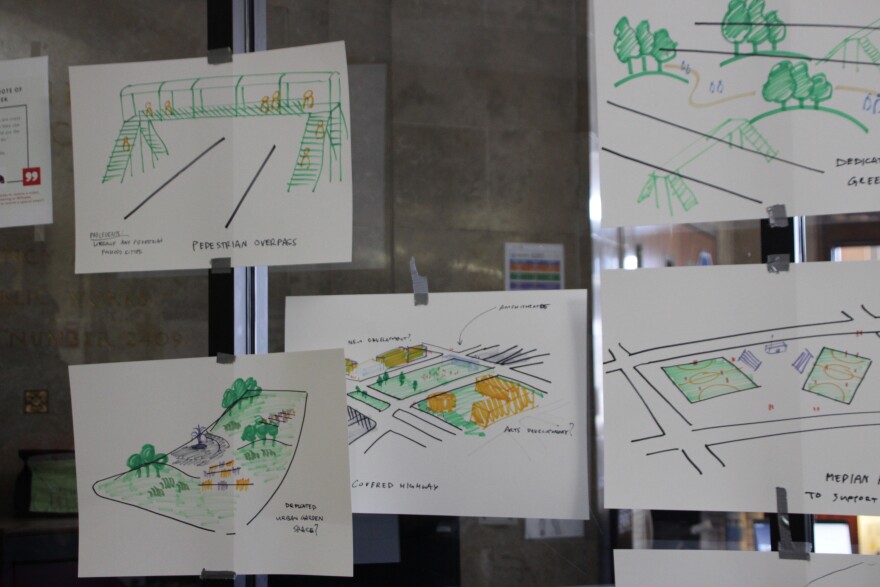At a community meeting this June inside the Blue Parkway Sun Fresh in east Kansas City, residents gathered around tables with large maps showcasing the path of U.S. Highway 71. With facilitators from the city, they discussed the many problems caused by the highway, and the improvements they want to see to make the neighborhoods around it safer.
Floating among the dozens of residents were local artists armed with markers and pencils, documenting the meeting and conversations through illustrations and sketches — “reportage-style drawing,” as artist Juan Carlos Franco described it.
“We sketch out what's going on,” Franco said. “We draw what is interesting to us, and then eventually we start having conversations with people, and we're able to eke out their ideas and manifest them visually.”
Most public city meetings are neither accompanied nor documented by local artists like this. But it’s playing a role in Kansas City’s Reconnecting the East Side project, an initiative to study how the city can remedy some of the harms caused by Highway 71 when it tore through majority Black neighborhoods east of Troost Avenue decades ago.
Artists with Studio Cheeks, in Kansas City’s Historic Northeast, have attended community summit meetings about the highway and created art that reflects the meetings, and the ideas they hear from residents.
“We kind of do an ‘art therapy’ sort of session where we talk about what they're thinking and how they feel,” Franco said. “And that becomes one of our art pieces.”

Some are sketches done on the fly. Others are larger works, like a map sketched in white on an almost black background.
“The end result is that we're going to have a lot of art about this whole process. And, hopefully, maybe some of that art will be used to influence or help ideate what could go on in the 71 corridor,” Franco said.

Highway 71 was first conceived in the 1950s as the South Midtown Freeway — a major north-south artery to connect Kansas City’s growing suburban population to downtown. Local leaders decided in 1965 to build the expressway through the heart of many of the city’s predominantly Black neighborhoods.
Two thousand homes in its path were destroyed, and the National Association for the Advancement of Colored People estimates the project impacted 25,000 people. Entire families were displaced and communities were split apart by the 10-mile long stretch of highway that took decades to build because of protracted battles in court. Construction finished in 2001.
Now, with support from a $5 million federal grant from former President Joe Biden’s administration, the city is looking at how to make the neighborhoods around the highway safer, particularly from Martin Luther King Jr. Boulevard south to 85th Street. This stretch is prone to car crashes, and requires pedestrians traveling across it to cross six lanes of the highway.
The city is beginning these efforts with community summit meetings this year to hear from residents who live around the highway and were impacted by its construction. Incorporating the work of local artists is helping bring people’s ideas to life.
Local officials have emphasized the importance of prioritizing the stories and ideas of people most impacted by Highway 71. That stood out to Franco, who said it’s one of the first times he’s seen politicians admit that policy decisions like the highway caused harm — and show willingness to fix it.
“So I think just being able to see that has kind of given us a little bit of hope and a little bit of excitement as to what this might become,” Franco said.

Working on this project is also personal for many of the artists involved, he said, because many live along that highway corridor.
Artist Cadence Learned moved to Kansas City in 2020, in the midst of the Black Lives Matter protests that summer.
“Driving around, being my first time exploring the city, it was blaringly obvious the way that the highway had taken effect on neighborhoods,” they said.
Learned said people at the first community meeting in March were hesitant to talk with them. They said more residents opened up to them at the second meeting in June.
“I think when people can actually see something manifest in front of them — their idea come to life — they already feel much more connected to seeing that through to an outcome,” they said.

Artist Morsal Ibrahimi said visualizing people’s ideas about Highway 71 gives a sense of hope to the city’s efforts.
“I just really loved seeing people's ideas and applying people's ideas of what could be there, what should be there, what they deserve,” Ibrahimi said. “Like art, businesses, small businesses, a grocery store — things that should be accessible and comfortable for a community.”
Two more community summits are planned for later this year. The finalized sketches and illustrations will be published and digitized online. Studio Cheeks is also working on displaying the pieces at a gallery to commemorate the project.






